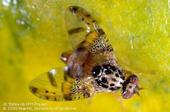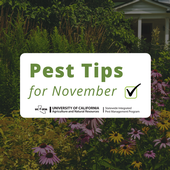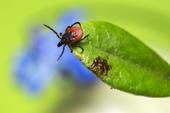- Author: Karey Windbiel

Change is in the air. Weather, daylight savings, politics, holiday decorations, and yes, websites.
You may have noticed the UC Statewide IPM Program's website is undergoing some style changes. Just this week, the home page changed from the style we've had for the last 15 or so years (Figure 1), to a new look (Figure 2). What does this mean?
The UC IPM Program is making some major style and navigation changes to our website to make our site more modern and accessible. In the coming months, you will see changes to both the style and navigation of the Home and Landscape section of the website. Several pages (such as the
- Author: Cherie Shook

The invasive pest spotlight focuses on emerging or potential invasive pests in California. In this issue we are covering the Mediterranean fruit fly.
Mediterranean Fruit Fly Facts
The Mediterranean fruit fly, Ceratitis capitata, commonly called Medfly, attacks more than 260 different plant species. It can be especially damaging to mango, citrus, grapes, and stone fruits. The Medfly originated in Africa and has spread around the world, becoming one of the most destructive agricultural pests. Despite recent successful eradication efforts in California, Mediterranean fruit fly was detected in Alameda County and prompted a quarantine in September 2024.
The adult Medfly is...

The common insecticide imidacloprid, and the related active ingredients acetamiprid, clothianidin, dinotefuran, and thiamethoxam, belong to the pesticide group neonicotinoids. Neonicotinoids have been linked to the decline in honey bee and other pollinator populations. To address these concerns, the California legislature recently put into law AB 363.
Starting January 1, 2025, neonicotinoid pesticides in California for non-agricultural outdoor use will only be available for sale at licensed pest control dealers and limited for possession and use by certified pesticide applicators. Sale of neonicotinoids in retail nurseries and garden centers and the possession or use of these pesticides by unlicensed applicators will no...

Rainy, cool weather is fast approaching for many parts of California. To help you determine what to do in the landscape during this time of the year UC IPM offers a Seasonal Landscape IPM Checklist. The online checklist provides monthly pest management to-dos for your region so you can prevent pests and their damage in the garden and landscape.
Here are some general pest tips for the month of November:
- Apply a preventive spray for peach leaf curl once or more AFTER leaf drop in the fall if peach leaf curl has been a problem on nectarine or...
- Author: California Department of Public Health, Vector-Borne Disease Section

You might think ticks are found only on hiking trails or in wild, natural areas, but in some parts of California, ticks can also live in backyards and neighborhoods. Californians living near natural areas (such as open fields, parks, or urban hiking trails) should get to know their arachnid neighbors and learn how to avoid ticks at home.
Meet the Western Blacklegged Tick (Ixodes pacificus)
Ticks are found outdoors in brushy, wooded areas on plants, rocks, logs, and in leaves and twigs on the ground. Beginning in fall, adult western blacklegged ticks emerge in California, especially in northern coastal counties and the Sierra Nevada foothills. These ticks lurk on bushes, shrubs, and the...


